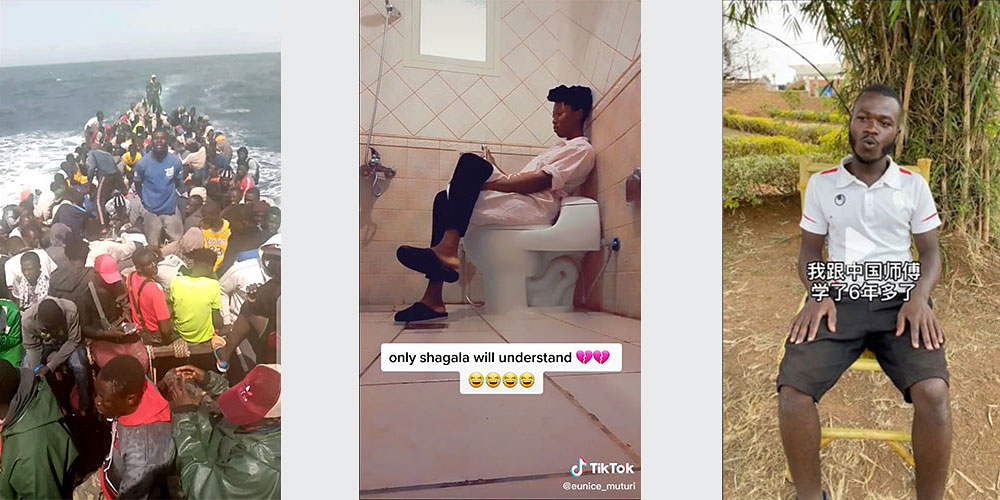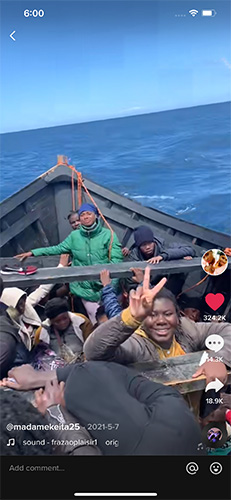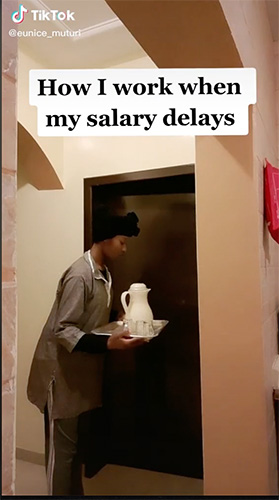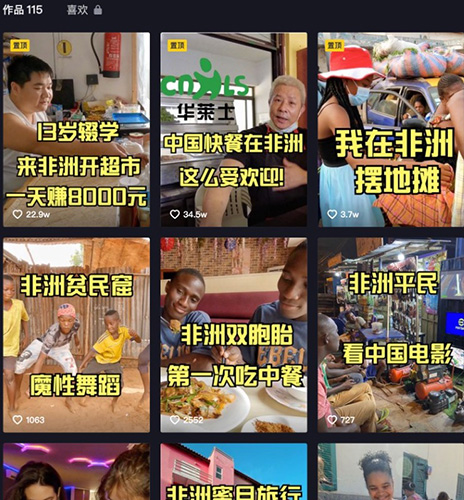Ethnographic research with TikTok
In social media, people share snippets of their lives with others. For researchers, these platforms are a treasure trove. In her blog post, ethnologist Lesley Nicole Braun explains what insights into distant realities of life she and her master's students Anna Vollmer Mateus and Xiao Meng have gained from TikTok videos and conversations with their creators.
13 June 2022
An African woman washes her clothes in a picturesque river, describing her task in Mandarin as she does it. A Kenyan domestic worker prepares a meal in a kitchen in Saudi Arabia and explains with a wink how to avoid getting caught sneaking food from her employer's refrigerator. A Chinese entrepreneur living in Tanzania presents a new business opportunity to other entrepreneurs who are considering leaving China for Africa. These are just a few examples of TikTok videos in which people share intimate aspects of their lives, and especially their work.
When the pandemic brought physical travel to a standstill, many researchers were left with little choice but to move some of their work online. Our project, which began in the summer of 2021, investigates the world of TikTok, a vernacular form of social media with approximately one billion registered users worldwide.
Endeavoring to connect with the content creators (TikTokers) themselves, we explore new methods and concerns associated with digital ethnography, and investigate the potential for understanding people’s lifeworlds at a distance.
Here we present three case studies that reveal some of the many ways in which people make their lives visible—sometimes in the hope of monetizing their online performances.
Case 1: Virtual boat crossings
One TikToker with whom we have built a rapport is a young migrant from Dakar in Senegal who recorded his journey across the Mediterranean in a crowded wooden boat. The young man posted a short video of himself and the other passengers floating at sea after several days without food and water. He films the young people in the boat, some of whom wave to the camera. The video is set to a popular song from Ivory Coast. In another video, he addresses viewers in his native Wolof. Some of his TikToks have been watched over a million times and have been commented on by viewers across the African diaspora.
On a video call from his parents’ home, he told us that he never made it to Spain and is still living in Dakar. When we asked why he decided to share his experience on TikTok, he said that he simply wanted people to see what he had endured. In later conversations, he spoke about his dreams of becoming a professional wrestler and how he hoped his TikTok profile would help him build an international fan base.
Case 2: Precarious working conditions under #shagala
Under the hashtag #shagala, women from Africa who work in domestic roles in Arabic-speaking countries share content about their precarious working conditions. “Shagala” is a term mostly used in the Gulf countries and means “servant” or “maid.” Some videos jokingly portray the pressures relating to getting paid, while others show comedic examples of “bad” behavior—such as resting instead of working, or “stealing” food. Other creators are more serious, sharing the heartache of being unable to travel home for long periods, the tiredness that comes from working long hours, and their anger at the physical and emotional abuse they encounter at work.
The hard-earned visibility gained on TikTok can also be used for offline endeavors. One worker explained that she sees TikTok as a stepping stone to launching a business. A couple of weeks later, her account was banned due to abusive reporting. Despite this setback, she is planning to build up her presence again.
#Shagala TikTok shows us the often precarious paths these workers tread and the layered role these videos play in their lives. Both the work involved in creating the content and the labor depicted in the content itself reflect a process of negotiating vulnerability.
Case 3: Constructed Africa
To access Douyin, the Chinese version of TikTok, you need a Chinese SIM card. Douyin has emerged as a portal through which images of Africa are constructed and presented to Chinese audiences. For instance, Chinese teachers at Confucius Institutes in the Comoro Islands make videos about their daily activities, as do Chinese backpackers traveling through Togo. Their TikToks capture encounters with their compatriots working in small shops, restaurants and development projects.
Under the hashtag 非洲 (FeiZhou, “Africa” in Chinese) and its 81 sub-hashtags, Africans talk about their daily lives, sometimes in basic Mandarin. The most popular sub-hashtag comprises videos of Chinese businessmen. One of them, having lived in Tanzania for more than 17 years, introduces Chinese audiences, who have little or no familiarity with the region, to what he refers to as “the local culture.”
By interviewing some of the creators, we learned that many of the videos showing a particular vision of Africa are in fact acted out by local, paid performers to entice Chinese consumers to purchase products such as handicrafts and coffee beans.
This raises questions around ethical labor practices, especially as creators are capitalizing on the performances of people who may not have access to the final content.
New perspectives beyond scrolling
TikTok offers a space to promote personas and experiences that can potentially be leveraged to generate income. Rather than writing them off as trivial, time-wasting activities, these videos can be understood as cultural artifacts worthy of anthropological research.
For instance, researchers can glean new perspectives around migration, the commodification of culture, self-representation and new transnational labor practices. These perspectives become deeper and more nuanced when one moves beyond merely scrolling and establishes a relationship with the creators themselves.
This study is part of a research project. Further information: www.travail-travel-traders.com
Dr. Lesley Nicole Braun investigates the relationship between China and Africa. Her current project entitled “Travail-Travel-Traders” focuses on the growing interconnectivity between China and Africa, especially with regard to African migrants. It is funded by a Swiss National Science Foundation Ambizione Grant.





